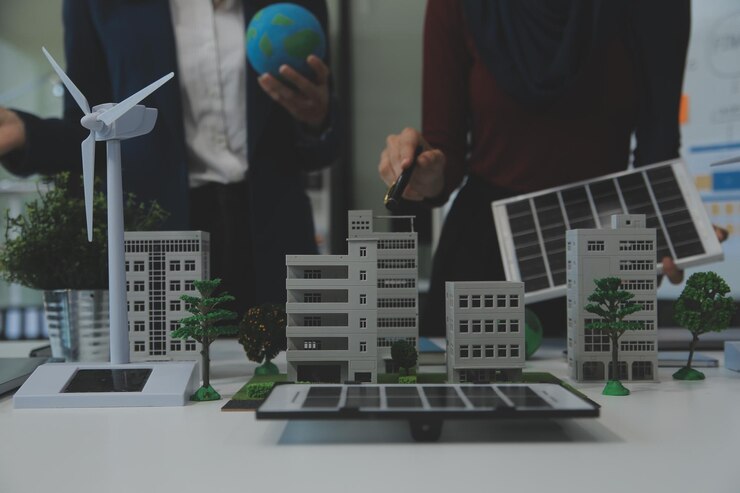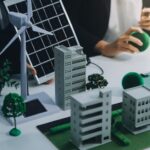In today’s world, energy efficiency in buildings has become a critical component of sustainability. As the global demand for energy continues to rise, it’s essential for residential, commercial, and industrial buildings to adopt more energy-efficient practices. From reducing operational costs to lowering carbon footprints, energy efficiency plays a vital role in creating greener, more cost-effective structures.
This blog will explore various ways in which energy efficiency in buildings can be achieved, the importance of incorporating energy-saving solutions, and how sustainable building practices are changing the construction industry.
Why is Energy Efficiency in Buildings Important?
Buildings account for a significant portion of global energy consumption. In fact, they are responsible for about 40% of global energy use and 36% of CO2 emissions. This makes them a prime target for energy-saving solutions that can not only reduce energy consumption but also help combat climate change.
By optimizing energy efficiency in buildings, owners and operators can lower energy bills, reduce the environmental impact, and contribute to a more sustainable future. In addition, implementing energy-saving measures can increase the value of the property, as modern, energy-efficient buildings are becoming increasingly attractive to tenants and buyers who prioritize sustainability.
Strategies to Improve Energy Efficiency in Buildings
There are several approaches to improving energy efficiency in buildings, ranging from minor adjustments to major upgrades. Below are some of the most effective strategies that can be implemented.
1. Energy-Efficient Insulation and Windows
One of the most significant ways to improve energy efficiency in buildings is by improving insulation. Proper insulation in walls, ceilings, and floors prevents heat loss in the winter and keeps the building cooler during the summer, reducing the need for heating and air conditioning.
Upgrading to energy-efficient windows is another crucial strategy. Windows that are designed to reduce heat transfer and are equipped with double or triple glazing can significantly cut energy costs. The right windows can reduce the need for artificial heating and cooling, providing better temperature regulation and reducing energy consumption.
2. Smart Heating, Ventilation, and Air Conditioning (HVAC) Systems
Energy-efficient HVAC systems play a pivotal role in improving energy efficiency in buildings. Traditional HVAC systems are often inefficient, consuming large amounts of energy to maintain consistent temperatures. However, newer systems incorporate advanced technologies, such as variable refrigerant flow (VRF), to optimize energy use while maintaining comfort.
Implementing a smart HVAC system can further enhance energy savings. Smart thermostats and sensors help monitor temperature fluctuations and adjust settings based on occupancy, preventing the overuse of heating or cooling. This can lead to a significant reduction in energy waste and costs.
3. Energy-Efficient Lighting Systems
Lighting accounts for a significant portion of energy consumption in buildings. Switching to LED lights instead of traditional incandescent bulbs can drastically reduce energy use. LED lighting consumes up to 75% less energy and lasts much longer, making it a cost-effective option for both new and existing buildings.
Additionally, installing motion sensors and smart lighting controls can ensure that lights are only on when needed, preventing unnecessary energy consumption. These simple solutions contribute to a more energy-efficient building without compromising on functionality or comfort.
4. Renewable Energy Integration
For buildings looking to go a step further in their energy efficiency efforts, integrating renewable energy sources, such as solar panels, can help meet a portion of the energy demand while reducing reliance on the grid. Solar energy systems are becoming increasingly affordable and can be installed on rooftops or as part of building designs.
Other renewable energy sources, such as wind power and geothermal energy, are also gaining traction in commercial buildings. By producing clean energy on-site, buildings can further reduce their carbon footprint and energy costs.
Benefits of Energy Efficiency in Buildings
The adoption of energy efficiency in buildings offers numerous benefits, both immediate and long-term. Here are some of the most notable advantages:
- Cost Savings: Energy-efficient buildings are significantly cheaper to operate, with reduced energy bills due to improved insulation, energy-efficient lighting, and smarter HVAC systems.
- Sustainability: By minimizing energy consumption and integrating renewable energy sources, buildings reduce their environmental impact and contribute to a more sustainable future.
- Comfort and Health: Energy-efficient buildings often have better indoor air quality, consistent temperatures, and improved lighting, providing a more comfortable and healthier environment for occupants.
- Property Value: Buildings with energy-efficient features are in high demand, and energy-saving solutions can increase a property’s value and attract tenants who prioritize sustainability.
Incorporating energy efficiency in buildings is not just a trend; it is a necessary move for creating sustainable and cost-effective spaces. By focusing on energy-efficient design, smart technologies, and renewable energy sources, we can drastically reduce energy consumption, minimize environmental impact, and enhance the comfort of building occupants. Whether building a new structure or retrofitting an existing one, implementing energy-saving solutions will yield long-term benefits for both building owners and the planet.
As we move toward a more sustainable future, energy efficiency in buildings will remain a key factor in reducing global energy consumption and promoting environmental stewardship.




